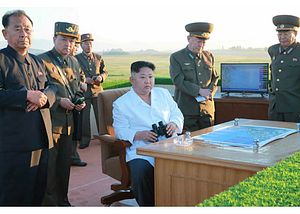On Sunday, North Korea’s Korean Central News Agency reported that the country’s supreme leader, Kim Jong-un, had supervised testing of what was described as “new-type anti-aircraft guided weapon system.”
First seen publicly at North Korea’s October 2010 parade and known as the KN-06, the system bears resemblance to the Russian S-300 (SA-10 Grumble) surface-to-air missile (SAM) system and China’s HQ-9 SAM, which is in itself an indigenously developed Chinese variant of the S-300.
The test, which took place at an unknown time over the weekend, comes one week after North Korea’s most recent ballistic missile test.
KCNA, quoting Kim Jong-un, said that the system was “perfect,” and that its “efficiency to detect and track targets has remarkably improved and its hitting accuracy has also increased, compared with those of last year.” The statement adds that “defects” in earlier testing were “perfectly overcome.”
Critically, as with last week’s testing of Pukkuksong-2 medium-range ballistic missile, Kim Jong-un, declared that the KN-06 had reached initial operational capability (IOC) and “should be mass-produced.”
Kim added that the system should be deployed “all over the country like forests so as to completely spoil the enemy’s wild dream to command the air, boasting of air supremacy, and weapon almighty.”
Images and video footage released by KCNA and Rodong Sinmun show the KN-06’s interceptor successfully ejecting from its canister, properly igniting its engines, and boosting into the air. The missile’s flight ceiling and maximum range are unknown.
North Korea would presumably look to deploy the KN-06 to deter aerial assault by U.S. and South Korean fighters in wartime. Depending on the missile’s range, however, U.S. and South Korean forces may be able to neutralize specific KN-06 batteries with longer-range stand-off weapons.

































